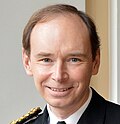| Office of the Second Sea Lord and Deputy Chief of the Naval Staff | |
|---|---|
 Ensign of the Royal Navy | |
since 30 September 2025 | |
| Ministry of Defence | |
| Abbreviation | 2SL/DCNS |
| Member of | Admiralty Board Navy Board |
| Reports to | First Sea Lord |
| Nominator | Secretary of State for Defence |
| Appointer | Prime Minister Subject to formal approval by the King-in-Council |
| Term length | Not fixed (typically 4–5 years) |
| Inaugural holder | Rear Admiral George Dundas |
| Formation | Second Naval Lord, 1830–1904 Second Sea Lord from 1904 |
The Second Sea Lord and Deputy Chief of the Naval Staff (formerly Second Sea Lord) is deputy to the First Sea Lord and the second highest-ranking officer currently to serve in the Royal Navy and is responsible for personnel and naval shore establishments. Originally titled Second Naval Lord in 1830, the post was restyled Second Sea Lord in 1904. They are based at Navy Command Headquarters.
Contents
- History
- Second Naval Lords, 1830–1904
- Second Sea Lords, 1904–1917
- Second Sea Lord and Chief of Naval Personnel 1917–1995
- Second Sea Lords and Commanders-in-Chief Naval Home Command, 1995–2012
- Second Sea Lords and Chiefs of Naval Personnel and Training, 2012–2015
- Second Sea Lord and Deputy Chief of the Naval Staff, 2015–present
- Departments under the office
- Current
- Former
- See also
- References











